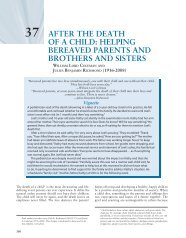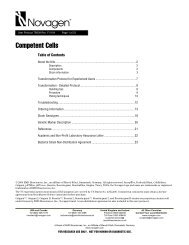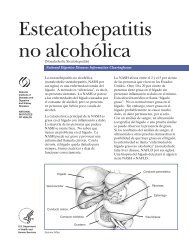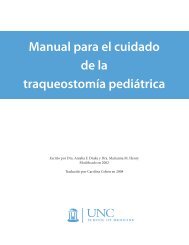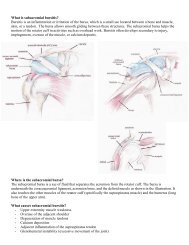Affinity Chromatography Handbook
Affinity Chromatography Handbook
Affinity Chromatography Handbook
You also want an ePaper? Increase the reach of your titles
YUMPU automatically turns print PDFs into web optimized ePapers that Google loves.
28<br />
HiTrap Protein G HP, Protein G Sepharose 4 Fast Flow, MAbTrap Kit<br />
Protein G, a cell surface protein from Group G streptococci, is a type III Fc-receptor.<br />
Protein G binds through a non-immune mechanism. Like protein A, protein G binds<br />
specifically to the Fc region of IgG, but it binds more strongly to several polyclonal IgGs<br />
(Table 2) and to human IgG 3 . Under standard buffer conditions, protein G binds to all<br />
human subclasses and all mouse IgG subclasses, including mouse IgG 1 . Protein G also<br />
binds rat IgG 2a and IgG 2b , which either do not bind or bind weakly to protein A.<br />
Amersham Biosciences offers a recombinant form of protein G from which the albuminbinding<br />
region of the native molecule has been deleted genetically, thereby avoiding undesirable<br />
reactions with albumin. Recombinant protein G contains two Fc binding regions.<br />
Protein G Sepharose is a better choice for general purpose capture of antibodies since it<br />
binds a broader range of IgG from eukaryotic species and binds more classes of IgG.<br />
Usually protein G has a greater affinity than protein A for IgG and exhibits minimal<br />
binding to albumin, resulting in cleaner preparations and greater yields. The binding strength<br />
of protein G for IgG depends on the source species and subclass of the immunoglobulin.<br />
The dynamic binding capacity depends on the binding strength and also on several other<br />
factors, such as flow rate during sample application.<br />
Many antibodies also interact via the Fab region with a low affinity site on protein G.<br />
Protein G does not appear to bind human myeloma IgM, IgA or IgE, although some do<br />
bind weakly to protein A.<br />
Leakage of ligands from an affinity medium is always a possibility, especially if harsh elution<br />
conditions are used. The multi-point attachment of protein G to Sepharose results in very<br />
low leakage levels over a wide range of elution conditions.<br />
Purification options<br />
Binding capacity Maximum<br />
operating flow<br />
Comments<br />
HiTrap<br />
Protein G HP<br />
Human IgG, > 25 mg/column<br />
Human IgG, >125 mg/column<br />
4 ml/min (1 ml column)<br />
20 ml/min (5 ml column)<br />
Purification of IgG, fragments and<br />
.<br />
subclasses, including human IgG3 Strong affinity for monoclonal<br />
mouse IgG1 and rat IgG.<br />
Prepacked columns.<br />
MAbTrap Kit Human IgG, > 25 mg/column 4 ml/min Purification of IgG, fragments and<br />
subclasses, including human IgG3 .<br />
Strong affinity for monoclonal mouse<br />
IgG1 and rat IgG.<br />
Complete kit contains HiTrap<br />
Protein G HP (1 x 1 ml), accessories,<br />
pre-made buffers for 10 purifications<br />
and detailed experimental protocols.<br />
Protein G Human IgG, > 20 mg/ml medium 400 cm/h* Supplied as a suspension ready<br />
Sepharose 4 Cow IgG, 23 mg/ml medium for column packing.<br />
Fast Flow Goat IgG, 19 mg/ml medium<br />
Guinea pig IgG, 17 mg/ml medium<br />
Mouse IgG, 10 mg/ml medium<br />
Rat IgG, 7 mg/ml medium<br />
*See Appendix 4 to convert linear flow (cm/h) to volumetric flow rate. Maximum operating flow is calculated from<br />
measurement in a packed column with a bed height of 10 cm and i.d. of 5 cm.








